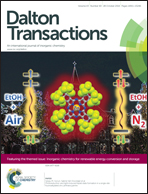Two new zinc(ii) coordination complexes with helix characteristics showing both interpenetration and self-catenation features: a platform for the synthesis of chiral and catenated structures assembled by length-modulated dicarboxylates†
Abstract
Two new zinc coordination complexes, namely [Zn2(tib)4/3(L1)2]·DMA (1) and [Zn2(tib)4/3(L2)2]·H2O (2) (tib = 1,3,5-tris(1-imidazolyl)benzene, H2L1 = biphenyl-4,4′-dicarboxylic acid, H2L2 = 4,4′-(2,2′-oxybis(ethane-2,1-diyl)bis(oxy))dibenzoic acid and DMA = N,N-dimethylacetamide), are obtained using achiral mixed ligands and characterized using elemental analysis, IR and X-ray crystallography. Compounds 1 and 2 both display intriguing structural features of both interpenetration and self-catenation. By careful inspection of the two structures, we found that the Zn(II) cations, the tib ligands, and the dicarboxylic anions show the same coordination modes or analogous configurations. Compound 1 is chiral, which was confirmed by measuring the optical rotation of the bulk samples using solid-state circular dichroism (CD). It is comprised of two crystallographically independent interpenetrated 3D motifs, each containing interlaced triple-stranded right- and left-handed Zn–L1–Zn helical chains and chiral 2D [Zn(tib)2/3] layers. Both motifs display binodal (3,4)-coordinated 3D self-catenated networks with the point symbol (103)2(106)3 and the vertex symbols [1013·1013·1013] and [107·107·108·1010·1011·1011]. However, the two types of helical chains are not racemic due to the differences between the two kinds of L1 anions, and the two types of chiral 2D [Zn(tib)2/3]2+ layers are not enantiomeric either due to the different configurations of the tib ligands. Therefore, the two motifs are not enantiomers. Compound 2 is achiral, containing Zn–L2–Zn zigzag chains that span into three directions and chiral 2D [Zn(tib)2/3] layers. The overall 3D network is a new binodal (3,4)-coordinated self-catenated network with the point symbol (103)2(106)3 and the vertex symbols [107·107·107] and [102·104·105·105·105·105]. Two of these networks interpenetrate. Their chiral and achiral structures are mainly modulated by the length of the dicarboxylates. As expected, compounds 1 and 2 show photoluminescence behaviors and compound 1 shows a ferroelectric behavior. Thermogravimetric studies of 1 and 2 have also been performed. We examined all 48 known structures containing the tib ligand and drew the conclusion that the metal + tib combination, modulated by the prolonged L ligands, can be a good basis for new chiral and catenated structures.


 Please wait while we load your content...
Please wait while we load your content...